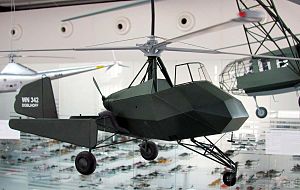Doblhoff WNF 342: Difference between revisions
m →Variants: http→https for Google Books and Google News using AWB |
Rescuing 1 sources and tagging 0 as dead. #IABot (v1.2.7.1) |
||
| Line 130: | Line 130: | ||
{{refbegin}} |
{{refbegin}} |
||
*{{cite book |last= |first= |authorlink= |coauthors= |title= The [[Illustrated Encyclopedia of Aircraft]] (Part Work 1982-1985)|year= |publisher= Orbis Publishing|location= |issn=|pages=}} |
*{{cite book |last= |first= |authorlink= |coauthors= |title= The [[Illustrated Encyclopedia of Aircraft]] (Part Work 1982-1985)|year= |publisher= Orbis Publishing|location= |issn=|pages=}} |
||
*[http://www.verticalmag.com/news/article/VerticalRewindSpoilsofWar Vertical Rewind: Spoils of War] |
*[https://web.archive.org/web/20150425065608/http://www.verticalmag.com/news/article/VerticalRewindSpoilsofWar Vertical Rewind: Spoils of War] |
||
{{refend}} |
{{refend}} |
||
Revision as of 11:49, 14 December 2016
| Doblhoff/WNF 342 | |
|---|---|

| |
| Doblhoff WNF 342 V4 model in the Hubschraubermuseum Bückeburg (Bückeburg Helicopter Museum) | |
| Role | Tip jet research helicopter |
| National origin | Austria |
| Manufacturer | Wiener-Neustädter Flugzeugwerke |
| Designer | Friedrich von Doblhoff |
| First flight | 1943 |
| Number built | 3 |
The Doblhoff/WNF 342 was the first helicopter to take off and land using Tip jets to drive the rotor.
Development
The WNF 342 was designed for a German Navy requirement for an observation platform for use from small ships and submarines.[1]
The conventional piston engine drove both a small propeller (to provide airflow across a rudder) and an air compressor to provide air (subsequently mixed with fuel) through the rotor head and hollow rotor blades to a combustion chamber at the rotor tips.[2] As a research helicopter it was a simple design to allow modification.[who?]
Variants
V1/V2: The first helicopter was initially powered by a 60 horsepower (45 kW) engine (V1) and then a 90 horsepower (67 kW) engine (V2)—both by Walter Mikron. It first flew in 1943,[3] and was captured with V4 at Zell am See.
V3: The second WNF 342 had a larger rotor and was destroyed during testing.

V4: The last unit produced was a two-seat variant with new collective and cyclic controls.[clarification needed] After 25 flight hours it was captured by United States forces[4] and on July 19, 1945, shipped to the US under Operation Lusty on the HMS Reaper (D82).[1]
Specifications (V4)
Data from Illustrated Encyclopedia of Aircraft[3]
General characteristics
- Crew: 2
Performance
See also
Related lists
References
- ^ "Doblhoff". Hubschrauber Museum. Retrieved 2016-04-14.
- ^ Ford, Roger (2013). Germany's Secret Weapons of World War II. London, United Kingdom: Amber Books. p. 224. ISBN 9781909160569.
{{cite book}}:|access-date=requires|url=(help) - ^ a b Orbis 1985, pp. 1454–1455
- ^ Apostolo, Giorgio. The Illustrated Encyclopedia of Helicopters, pp. 18, 126. Bonanza Books, New York, 1984. ISBN 0-517-43935-2.
- The Illustrated Encyclopedia of Aircraft (Part Work 1982-1985). Orbis Publishing.
{{cite book}}: Cite has empty unknown parameter:|coauthors=(help) - Vertical Rewind: Spoils of War
